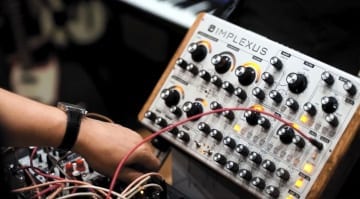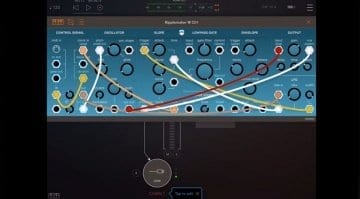Breaking news: East Coast and West Coast synthesis is a lie!
According to a series of videos by synthesizer historian Marc Doty the East Coast and West Coast paradigm is a myth that should be rejected.
The Littoral Myth of Coastal Synthesis
Mark Doty isn’t one to shy away from controversy. He likes nothing better than to stir up a hornet’s nest of passionate paraphonic nerds with his inconvenient facts about polyphony and synthesizer voice architecture. In his latest series of videos, he takes on the perception of East Coast and West Coast American synthesizer culture. He suggests that while the paradigm can be helpful, it’s not in the least bit accurate.
It’s certainly true that Bob Moog was building synthesizers on the East Coast at the same time that Don Buchla was building synths on the West Coast. But it’s become a way of describing certain synthesizers that don’t really hold up to scrutiny.
East Coast Moog
For instance, people say East Coast synths are all about Subtractive Synthesis. Subtractive is the idea of starting with a harmonically rich waveform and then using a filter to subtract harmonics from it. That’s your classic sawtooth or square waveform into a low pass filter voicing that feels very familiar. The fact is that Moog modular started off with sine wave oscillators which lent themselves more to additive synthesis and Frequency Modulation.
Subtractive elements existed in Moog, but it wasn’t the focus. Even in the Minimoog you can do so much more than simply filter waveforms, and even add more harmonics through self-oscillation. So, Marc is saying that calling a synthesizer “subtractive” is not an effective way of defining what it can do because, more often than not, harmonics can also be added.
You are currently viewing a placeholder content from YouTube. To access the actual content, click the button below. Please note that doing so will share data with third-party providers.
West Coast Buchla
When it comes to the West Coast sound associated with Buchla, it’s often described as “Additive“. Additive synthesis is where you take simple waveforms and add further harmonics with the intention of synthesizing new complex timbres. Buchla did introduce the concept of wave folding, where you can take a sine wave which has no harmonics and fold it over to produce loads of harmonics in a much more complex waveform. But wave folding is not true additive synthesis, although it is a useful distinction of Buchla. So, to describe Buchla as additive would be inaccurate. So to also use it as a way of distinguishing it from Moog is even less accurate.
You are currently viewing a placeholder content from YouTube. To access the actual content, click the button below. Please note that doing so will share data with third-party providers.
Marc goes on to demonstrate that actually, Buchla can also be quite subtractive because it has a whole bunch of filters.
In the 12 episodes, he covers numerous ways that both Moog and Buchla have been described inaccurately, and it is absolutely fascinating. I always come away from his AutomaticGainsay channel feeling like I’ve learned something important.
Semantics?
I don’t think you can argue with Marc’s logic or historical accuracy. That does then lead you to wonder whether it’s all just semantics. Does it really matter how we describe these things as long as everyone knows what we’re talking about? But then it’s a huge presumption to think that everyone somehow already knows, and so all we do is reinforce something that isn’t really correct. Marc likes things to be correct, and that can be an uphill, but worthy struggle.
I think when I talk about synthesizers, I don’t tend to use absolutes. I might be inclined to say that something has a “West Coast vibe” by which I would mean that it emphasises wave folding and low-pass gates over filters and envelopes. So I think if we don’t get too tied up in our definitions then, as Marc acknowledges, it can be a useful way to distinguish between different approaches to synthesis.
I’ve highlighted the two main videos that hit on the most common preconceptions. But do go and watch them all because Marc is an interesting guy, and you are going to learn all sorts of very cool things about synths.
- AutomaticGainsay YouTube.
- Moog website.
- Buchla website.
- Moog products on Thomann (affiliate link).
- More from Moog.
- More from Buchla.
8 responses to “Breaking news: East Coast and West Coast synthesis is a lie!”

 3,4 / 5,0 |
3,4 / 5,0 | 







Check out the “I dream of wires” documentary from 2013. Distinct ‘East Coast’ and ‘West Coast’ synthesizer development was covered at length in there, too.
East Coast vs. West Coast is what killed Biggie and Tupac, let’s not go there…
‘categorizing’ music is pointless except for album sales.
(well… the videos are in depth, it’s only the title of this article that is misleading)
I really hate the East / West coast thing.
Not all synths are American!
Russia, Europe and others were all doing this.
Such lazy and presumptuous terminology.
Let’s get rid of a useful category because a rando on youtube says so.
what a redundant, waste of lifetime-discussion, yet interesting! It’s always good to learn stuff.
He does go on and on about the misapplication of the terms “subtractive” and “additive”.
I highly recommend the book “Analog Days” by Trevor Pinch and Frank Trocco. It tells the fascinating stories of what Moog, Buchla and others were up to.
You are currently viewing a placeholder content from Facebook. To access the actual content, click the button below. Please note that doing so will share data with third-party providers.
More InformationYou are currently viewing a placeholder content from Instagram. To access the actual content, click the button below. Please note that doing so will share data with third-party providers.
More InformationYou are currently viewing a placeholder content from X. To access the actual content, click the button below. Please note that doing so will share data with third-party providers.
More Information